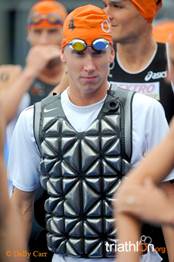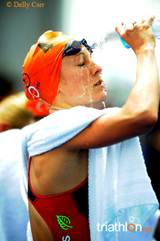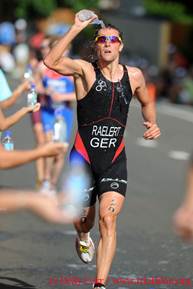It looks like the summer is going to be here soon, so it’s time to talk about racing in the heat! Heat is the number one inhibitor of athletic performance in endurance sports. In other words, no one races their fastest when it is hot!
 Physiologists define extreme heat as any race taking place in 80 degrees or more. Runners have long known that best performances occur in temperatures near 55 degrees. For every 10 degrees above that, race pace slows by a few percent.
Physiologists define extreme heat as any race taking place in 80 degrees or more. Runners have long known that best performances occur in temperatures near 55 degrees. For every 10 degrees above that, race pace slows by a few percent.
There is only so much blood in the body and when some of that blood is being diverted away from working muscles for cooling purposes, then we can’t do as much work. Also, an exercising body creates a tremendous amount of heat. Once core temperature exceeds 38 degrees Celsius (100.4 degrees Fahrenheit), the brain forces the body to slow down so that core temperature does not become lethal.
Managing core temperature is the name of the game when racing in the heat. If you overheat the engine, then you fall apart and slow way down. In order to avoid overheating, you have to slow down (i.e. generate less heat)!
Respect the heat! The most recent Boston Marathon was run in 90-degree heat. The winner’s time was the slowest time posted since 1985. A conservative pace was the fastest way to get to the finish. If the lead runners had run their PR goal times in terms of pacing, they would have blown up around mile 20.
Bigger people do worse in the heat than smaller people—the more mass you have, the more heat you generate when exercising. At the 1996 Olympic marathon, scientists calculated the mass of the winner based on the air temp being 80 degrees with 60% humidity. In order to produce a time near 2:08, they predicted the winner would need to weight 45 kilos. They were off by one kilo. The winner weighed 44 kilos! So, if you are bigger, then you need to be even more conservative with the heat.
Here are some tips for racing the Sprint and Olympic distance races in the heat:
Start the race normally hydrated. Do not over hydrate or you will dilute your electrolytes. Sip on a sports drink that contains plenty of sodium in the morning of the race. Stay cool as long as possible. Do not get into your wetsuit too early!
Consider wearing a sleeveless wetsuit or no wetsuit if the water is in the 70s and the air temp is going to be above 80. If you start to overheat in the water, then the day is doomed. It is almost impossible to cool your core temperature down during the race unless you almost come to a halt.
Once you are out of the water, do not let your skin dry off. Splash cold water on your head, arms, legs and core. Pay attention to splash water especially on the legs as those are the muscles doing the most work. Splashing water on your head and neck can cool the blood in the brain and can trick the brain into thinking it is cooler than it really is. Remember how much water Floyd Landis splashed on himself on Stager 16 of the Tour in 2006!
 Slow down! Do not hammer at or above lactate threshold if you plan on running well. Your core temperature will elevate. It is easy do this since the evaporative cooling effect of the air on the bike makes it feel cooler than it is. If you start to feel hot on the bike then you have already accumulated too much heat – slow down. Aim at a conservative level 3-4 pace (sub threshold). The hotter it is, the slower you should go. Be sure to trust your perceived effort and speed. The heart rate will likely start climbing and be elevated all day on hot conditions.
Slow down! Do not hammer at or above lactate threshold if you plan on running well. Your core temperature will elevate. It is easy do this since the evaporative cooling effect of the air on the bike makes it feel cooler than it is. If you start to feel hot on the bike then you have already accumulated too much heat – slow down. Aim at a conservative level 3-4 pace (sub threshold). The hotter it is, the slower you should go. Be sure to trust your perceived effort and speed. The heart rate will likely start climbing and be elevated all day on hot conditions.
Get off of the bike and settle into a reasonable tempo pace (level 3) for the first mile. At the mile point, you will be able to assess if this pace is sustainable. If you are already suffering, then slow down a bit. If it feels sustainable, then it will likely be hard by the second mile. Focus on quick feet and maintaining a steady rhythm. Your focus is to not slow down the rest of the run. Your heart rate, perceived effort, and core temperature will inch upwards as the run goes on. What seemed like a reasonable tempo pace at mile one may feel like an all-out level 5b effort by mile 5! Start your kick with about 800m to the finish. If you start a mile out, you will likely burn up about 600yds later. Again, splash as much water on you as you can during the race!!
Your nutrition can remain the same as any Sprint or Olympic race. You might consider some salt tablets on the bike if you are a bigger athlete prone to muscle cramps in the heat.


